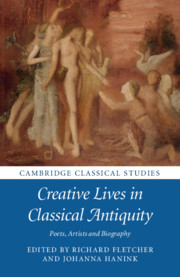Book contents
- Frontmatter
- Contents
- List of contributors
- List of illustrations
- Part I Opening remarks
- Part II Reviving dead poets
- Part III Lives in unexpected places
- Part IV Laughing matters and Lives of the mind
- Part V Portraits of the artist
- 11 ‘It is Orpheus when there is singing’: the mythical fabric of musical lives
- 12 The artist as anecdote: creating creators in ancient texts and modern art history
- 13 Freud and the biography of antiquity
- Envoi
- Works cited
- Index
12 - The artist as anecdote: creating creators in ancient texts and modern art history
from Part V - Portraits of the artist
Published online by Cambridge University Press: 01 December 2016
- Frontmatter
- Contents
- List of contributors
- List of illustrations
- Part I Opening remarks
- Part II Reviving dead poets
- Part III Lives in unexpected places
- Part IV Laughing matters and Lives of the mind
- Part V Portraits of the artist
- 11 ‘It is Orpheus when there is singing’: the mythical fabric of musical lives
- 12 The artist as anecdote: creating creators in ancient texts and modern art history
- 13 Freud and the biography of antiquity
- Envoi
- Works cited
- Index
Summary
In 2007, the Musée du Louvre devoted an exhibition to the fourth-century BC Greek sculptor Praxiteles that gathered together important evidence for famed works such as his Aphrodite of Knidos and Apollo Sauroktonos. Unlike conventional shows devoted to the work of single artists, the Louvre's curators were faced with a critical problem, for despite Praxiteles’ renown, not a single object survives that can be securely attributed to his hand. Instead, the museum displayed a wealth of Hellenistic and Roman emulations of Praxitelean sculptural types, together with some controversial late Classical pieces and, most tellingly, two empty statue bases from the Athenian Agora inscribed with the artist's name. An eloquent illustration of the challenges that face anyone attempting to recover the work of Greek ‘Old Masters’, the signature stripped of its sculptor's work speaks to the great chasm that separates textual evidence for the activities of Classical artists from the mass of unattributable objects that survive within the archaeological record. Although Praxiteles’ works were rapturously celebrated in ancient literature, the empty bases and imprecise ‘copies’ of his work that have come down to us from antiquity offer frustratingly vestigial traces of his reputed genius.
Faced with this enduring gap between reputation and realia, the Louvre's exhibition sought to convey the compelling nature of Praxiteles’ legacy by falling back on a familiar feature of the sculptor's biography – his relationship with the famed courtesan Phryne. Praxiteles’ lover and alleged model, claimed the museum's promotional material, ‘lies at the heart of a complex process of identification and attribution, involving the statues of Aphrodite for which she is thought to have posed, idealized portraits of her by Praxiteles, and draped or nude effigies which may represent either Phryne or Aphrodite’. In other words, it is impossible to recover and understand Praxiteles’ work without peering at it through the lens of a firmly established literary trope, passed down to us by later authors such as Pliny the Elder, Pausanias and Athenaeus. We need not question the Louvre's accompanying assertion that Phryne inspired a rich post-Classical visual tradition, most strikingly demonstrated by the exhibition's inclusion of Jean-Léon Gérome's Phryné devant l'Aréopage (1861), which depicts the orator Hyperides’ public revelation of Phryne's ‘heavenly’ body to counter charges of impiety (Figure 12.1).
- Type
- Chapter
- Information
- Creative Lives in Classical AntiquityPoets, Artists and Biography, pp. 274 - 304Publisher: Cambridge University PressPrint publication year: 2016
- 2
- Cited by



